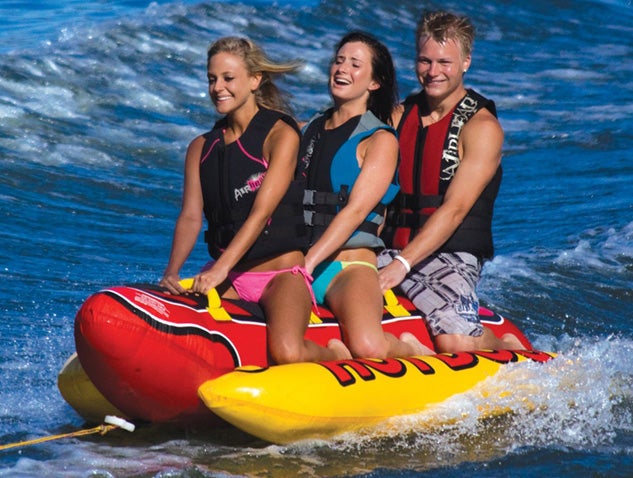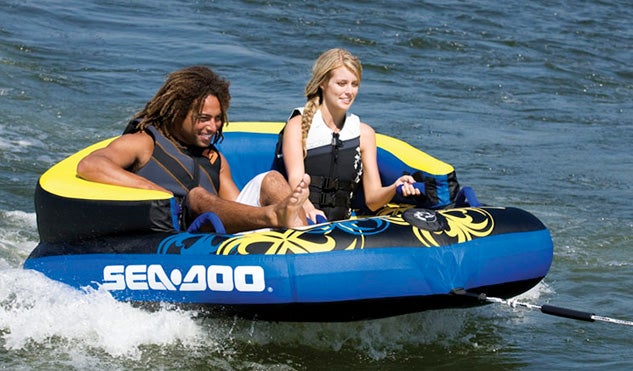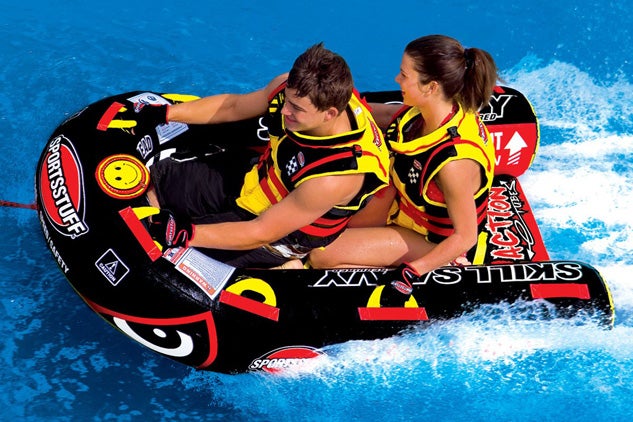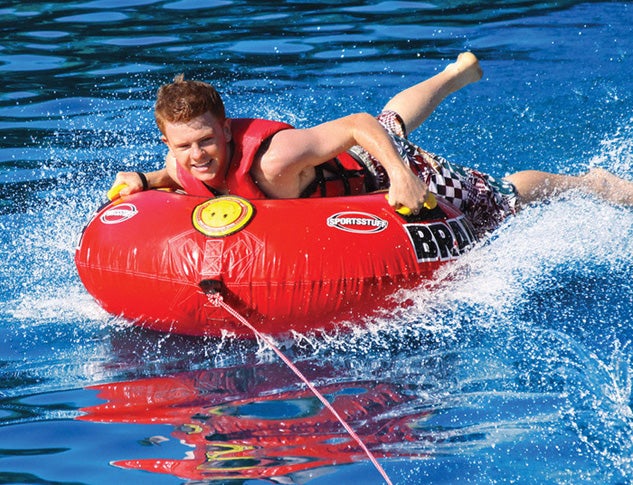Safe Tubing Behind Your PWC
How to tow an inflatable safely without killing the fun
Summer’s (finally) here, and chances are at some point you’re going to blow up some type of inflatable toy, hitch it to the back of your PWC, and then take your friends on one wild ride. And why not; it’s fun, a variation of what people have been doing behind boats for decades.
Inflatables are that one-size-fits-all toy to have in your arsenal, a toy that doesn’t discriminate based on size or athletic skill. Inflatables are relatively cheap, require minimal maintenance, and have virtually no real learning curve.
So why do I always add a disclaimer when recommending an inflatable to my friends? Because as simple as they are, inflatables can also be dangerous if used incorrectly. Just ask a doctor or an insurance agent. They’ll probably quickly tell you of the “tubing-related” back and neck injuries that spike in the summertime. Unfortunately, they may even tell you worse.
 Towing in inflatable on your PWC is a sure recipe for a great time, but there are dangers to consider.
Towing in inflatable on your PWC is a sure recipe for a great time, but there are dangers to consider.Rethinking your stance on inflatables? Don’t. They’re still the same fun, inexpensive fun mentioned above. They do, however, require a healthy dose of education and responsibility, especially on the part of the driver.
Coolest Toys of Summer: SPORTSSTUFF Slalom Jockey Towable
Before you hit the water, take a moment to read on.
Proper Inflation Is Key
Though inflating a big tube may seem like a no-brainer, there’s more to it than you think. Most of today’s inflatables have separate nylon covers, and for them to work properly – and safely – the tube or tubes within need to be fully inflated so that the cover fits snugly and without gaps.
 If your towable isn’t properly inflated, it won’t ride properly across the top of the water and could be a danger to its occupants.
If your towable isn’t properly inflated, it won’t ride properly across the top of the water and could be a danger to its occupants.For starters, proper inflation will substantially improve the ride. It allows the tube to ride properly across the water, lessens the strain on your tow PWC, and cushions the occupants against the jolts of wakes and waves. Proper inflation also, however, makes sure there are no dangerous gaps, loose spots, or puckers that could trap a rider’s hand, arm, leg, or foot. It’s no joke. I once personally witnessed a child caught between a loose cover and the under-inflated tube inside – and held head down under water – after the tube he was riding unexpectedly flipped. Proper inflation eliminates these gaps, and keeps riders safe.
Speaking of safe, also make sure passengers wear a PFD. Tubing may seem simple, but wearing a PFD still makes sense. And besides, it’s the law.
Driver Responsibility
Driving for a “tuber” also seems like a pretty easy task, but though the toy behind may be simpler than a ski or wakeboard, you still need to remember all the same basic tow guidelines. Keep your eyes on the water, hold and maintain a safe speed, and designate a spotter to keep his eyes on the inflatable and its passengers.
 The safety of those on the towable is in the hands of the driver. Take that responsibility seriously.
The safety of those on the towable is in the hands of the driver. Take that responsibility seriously.As the driver, you need to be aware of other boats, obstructions, dangerous wakes, the shoreline and anything else that could put your passengers at risk. Maintain a minimum distance of 50 yards from any of the above. The spotter, meanwhile, needs to relay info to the driver, such as whether or not the inflatable’s riders want to go faster or slower, stop the boat, or return to your starting point.
Though it seems like a tubing mainstay, avoid full turns that propel the tubers into a high-speed, whipping arc. In this scenario, it’s easy for the tube to drastically increase in speed, making the consequences of the inevitable fall much more severe. A careful driver can give their towed riders a gentle whip, but straighten back out before the inflatable reaches a dangerous rate of speed.
Learn How To Wakeskate Behind A PWC
As to that towing speed, keep in mind the ages – and desires – of those in tow. For kids under 12, a good maximum speed is 15 mph. Bump it up to 20 mph for kids 13-16, and no more than 25 mph for adults.
Don’t Misjudge Distance
One particularly dangerous scenario is when a driver executes a turn too close to a dock, piling, or other obstacle, and misjudges the path the inflatable will take.
 Keep a keen eye out for obstacles in or near the water and make sure the towable stays at least 50 feet away from trouble.
Keep a keen eye out for obstacles in or near the water and make sure the towable stays at least 50 feet away from trouble.Tubes have little, if any, directional control. Sadly, more than one news story can be found of a tube occupant accidentally whipped into an unavoidable obstacle and killed. Don’t chance it. Keep your minimum 50-yard distance, and never tow inflatables near shore, waterway markers, buoys, boats, or anything else that could cause injury.
Watch the Towrope
Picking up a downed rider, or circling as your rider gets ready to get underway? Watch the towrope. Though your PWC doesn’t have a propeller, it does have a pump, and crossing over that towrope will suck the rope into the pump cavity and most likely wind it tight around the driveshaft.
Make sure both the driver and spotter keep tabs on the rope whenever a rider is in the water. If you think you’re going to cross over a floating towrope, don’t hit the gas and try to escape. Better to kill the engine, clear the rope, and then restart.
Get PersonalWatercraft.com in your Inbox!
Like PersonalWatercraft.com on Facebook
Comments
Most Popular

Remembering the Sea-Doo XP

2025 Yamaha JetBlaster PRO 2-Up Review

2024 Kawasaki Jet Ski STX 160X Review

2024 Yamaha GP HO Review

2017 Kawasaki Jet Ski Ultra 310LX Review













 Your Privacy Choices
Your Privacy Choices